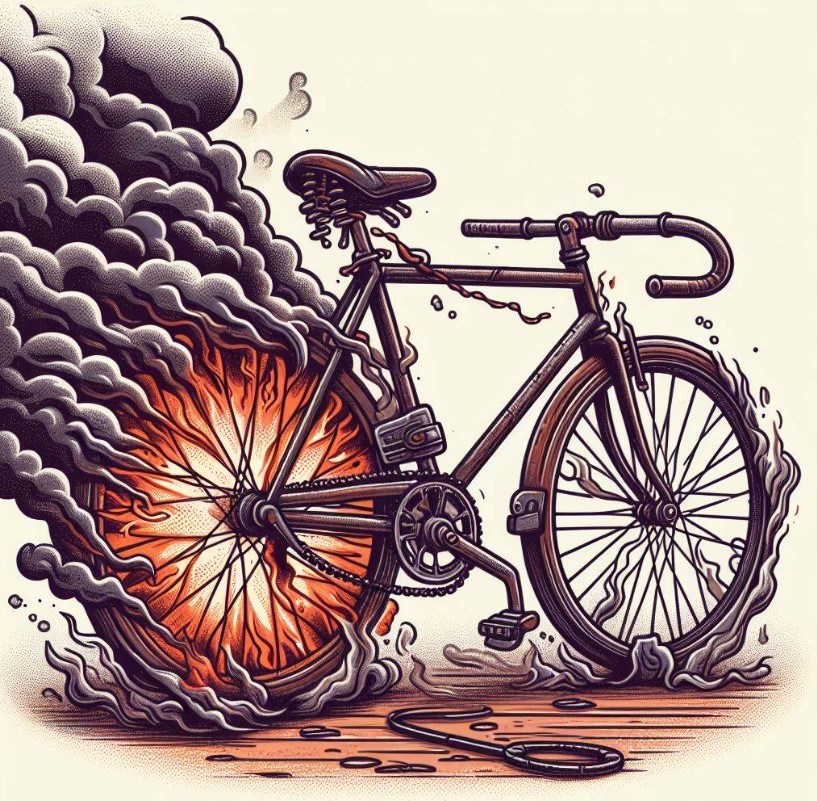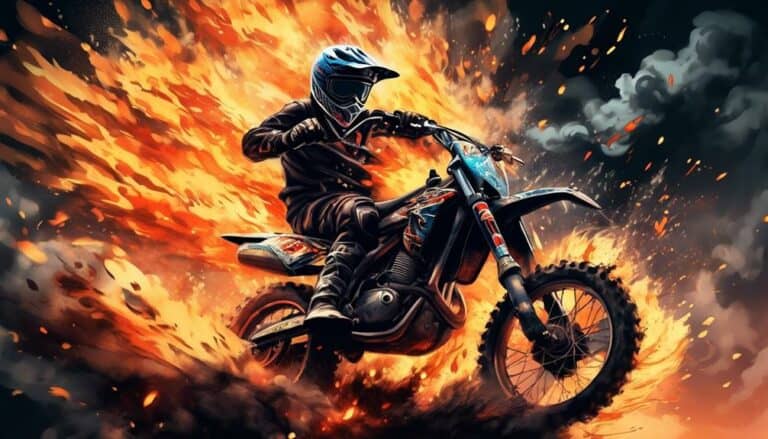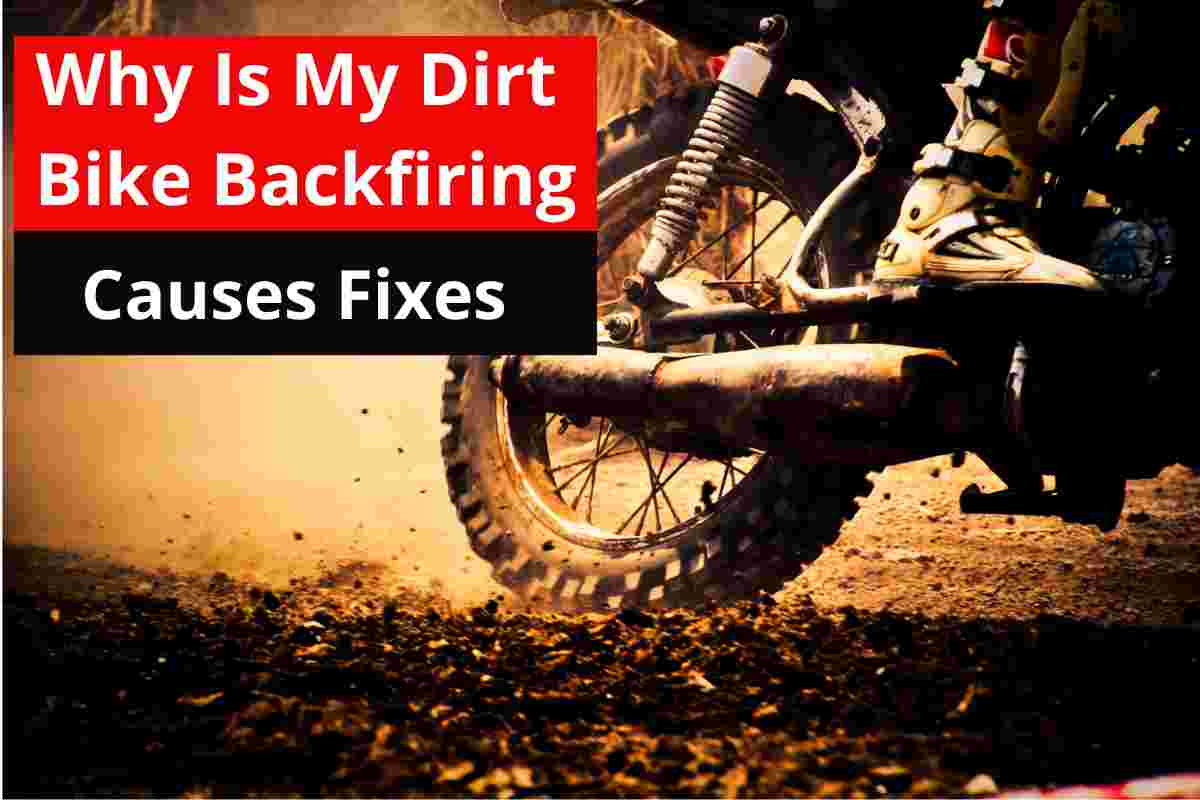Why does my bike backfire? This question often arises when a motorcycle emits a loud, unexpected popping sound from the exhaust, causing concern for riders. Backfires can be a symptom of various underlying issues, ranging from simple ignition problems to more complex engine malfunctions. Understanding the causes and troubleshooting steps for backfires is essential for ensuring a smooth and enjoyable riding experience.
Backfires are caused by a mixture of air and fuel combusting in the exhaust system instead of the combustion chamber. This can occur due to various factors, including improper ignition timing, a faulty fuel mixture, or problems with the exhaust system itself. When the mixture ignites in the exhaust, it creates a sudden pressure wave that travels back through the exhaust system, resulting in the characteristic popping sound.
Causes of Backfires
Backfires, those loud pops or bangs coming from your motorcycle’s exhaust, are often a sign of a problem. While they can be a minor annoyance, they can also indicate a serious issue that needs attention. Understanding the causes of backfires can help you diagnose and fix the problem.
Ignition Timing
The timing of the spark plug firing is crucial for proper combustion. If the spark occurs too early or too late, the fuel-air mixture may ignite prematurely or incompletely, resulting in a backfire.
Ignition timing refers to the precise moment when the spark plug ignites the fuel-air mixture in the combustion chamber.
An improperly adjusted ignition timing can cause the fuel to ignite before the piston reaches the top of its stroke, leading to a backfire through the intake manifold. Conversely, a delayed ignition can cause a backfire through the exhaust.
Fuel Mixture
The ratio of fuel to air in the combustion chamber is essential for efficient combustion. A rich fuel mixture (too much fuel) can lead to incomplete combustion and backfires.
A rich fuel mixture occurs when the fuel-air ratio is skewed towards fuel, meaning there is more fuel than air in the combustion chamber.
A rich fuel mixture can occur due to a faulty fuel injector, a clogged air filter, or a problem with the carburetor.
Exhaust System Issues
Leaks or blockages in the exhaust system can also cause backfires. A leak in the exhaust manifold or pipe can allow unburnt fuel to escape and ignite in the exhaust system, resulting in a backfire.
A leak in the exhaust system allows unburnt fuel to escape into the exhaust manifold or pipe, where it can ignite and cause a backfire.
Similarly, a clogged exhaust system can restrict the flow of exhaust gases, leading to a buildup of pressure that can cause a backfire.
Examples of Faulty Components
- Faulty Spark Plugs: Worn or fouled spark plugs can cause misfires and backfires. A worn spark plug may not generate enough spark to ignite the fuel-air mixture properly. A fouled spark plug is covered in carbon deposits that prevent the spark from reaching the fuel-air mixture.
- Clogged Air Filter: A clogged air filter restricts airflow to the engine, leading to a rich fuel mixture and backfires.
- Exhaust Leaks: Leaks in the exhaust manifold, pipes, or muffler can allow unburnt fuel to escape and ignite in the exhaust system, causing backfires.
Identifying the Problem

Backfires are often accompanied by telltale symptoms that can help pinpoint the underlying cause. These symptoms can provide valuable clues about the nature of the problem, guiding you towards the right solution.
Identifying Different Types of Backfires
Understanding the characteristics of backfires can help you differentiate between ignition and fuel delivery issues.
- Ignition-related backfires typically occur during acceleration or deceleration, producing a sharp, popping sound that might be accompanied by a momentary loss of power. These backfires often result from faulty spark plugs, ignition coils, or timing problems.
- Fuel delivery-related backfires usually occur during idle or low RPMs, emitting a dull, thudding sound. These backfires are often caused by issues with fuel injectors, air intake leaks, or carburetor problems.
Inspecting the Bike for Visual Clues
A thorough visual inspection of your bike can reveal potential causes of backfires. Here’s a step-by-step guide:
- Inspect the Spark Plugs: Examine the spark plugs for signs of wear, fouling, or damage. A worn or fouled spark plug can cause misfires and backfires.
- Check the Ignition Coils: Look for cracks, corrosion, or loose connections on the ignition coils. A faulty ignition coil can prevent proper spark delivery, leading to backfires.
- Inspect the Fuel Injectors: If your bike has fuel injection, check the fuel injectors for leaks, blockages, or signs of wear. A faulty fuel injector can cause an incorrect fuel-air mixture, resulting in backfires.
- Examine the Carburetor: If your bike has a carburetor, inspect it for dirt, debris, or signs of wear. A dirty or malfunctioning carburetor can cause fuel delivery problems, leading to backfires.
- Check the Air Intake: Look for leaks or cracks in the air intake system. An air leak can disrupt the air-fuel mixture, causing backfires.
- Inspect the Exhaust System: Examine the exhaust system for leaks, blockages, or damage. A damaged or clogged exhaust system can restrict exhaust flow, leading to backfires.
Identifying Other Potential Causes
Beyond the common culprits, other factors can contribute to backfires. These include:
- Faulty Engine Sensors: Sensors like the oxygen sensor or crankshaft position sensor play a crucial role in engine operation. A malfunctioning sensor can disrupt the engine’s timing and fuel delivery, leading to backfires.
- Incorrect Engine Timing: Proper engine timing is essential for smooth combustion. If the timing is off, it can cause backfires and other engine problems.
- Fuel Quality: Using low-quality or contaminated fuel can contribute to backfires. It’s important to use fuel that meets your bike’s specifications.
Troubleshooting Backfires

Backfires can be frustrating and sometimes even dangerous, but with a systematic approach, you can diagnose and fix the problem. This section Artikels a step-by-step process for troubleshooting backfires, starting with basic checks and progressing to more complex diagnostics.
Troubleshooting Steps
The following steps provide a logical framework for diagnosing backfires:
- Check for loose connections: Start by inspecting all electrical connections, including spark plug wires, ignition coils, and wiring to the fuel injectors. Loose connections can cause misfires and backfires.
- Inspect the spark plugs: Worn or fouled spark plugs can lead to misfires and backfires. Inspect the spark plugs for signs of wear, fouling, or damage. If necessary, replace them with new ones.
- Examine the air filter: A dirty or clogged air filter can restrict airflow and cause a lean condition, leading to backfires. Ensure the air filter is clean or replace it if necessary.
- Check the fuel lines and injectors: Inspect the fuel lines for leaks or blockages. Also, check the fuel injectors for proper operation and spray pattern.
- Inspect the exhaust system: Check the exhaust system for leaks, blockages, or damage. A leak in the exhaust system can cause backfires.
- Test the ignition system: Use a spark plug tester to verify that the spark plugs are firing properly. Check the timing of the ignition system to ensure it’s correctly set.
- Check the fuel pressure: Use a fuel pressure gauge to measure the fuel pressure. Low fuel pressure can cause a lean condition and backfires.
- Inspect the engine management system: If the backfire persists, it’s possible that there’s a problem with the engine management system. This could include faulty sensors, wiring issues, or a problem with the ECU itself.
Common Backfire Causes and Solutions
The following table summarizes common backfire causes, their symptoms, and recommended troubleshooting steps:
| Cause | Symptoms | Troubleshooting Steps |
|---|---|---|
| Lean fuel mixture | Backfires on acceleration, popping sounds from the exhaust, rough idle | Check for air leaks in the intake manifold, inspect the air filter, verify fuel pressure, adjust fuel mixture if necessary. |
| Rich fuel mixture | Backfires on deceleration, black smoke from the exhaust, poor fuel economy | Inspect fuel injectors for leaks, check for clogged fuel filters, adjust fuel mixture if necessary. |
| Ignition timing problems | Backfires on acceleration or deceleration, misfires | Check ignition timing, verify spark plug wires and connections, inspect the ignition coil. |
| Worn or damaged spark plugs | Misfires, backfires, rough idle | Inspect spark plugs for wear, fouling, or damage. Replace them if necessary. |
| Exhaust leaks | Backfires, loud exhaust noise | Inspect the exhaust system for leaks, repair or replace damaged components. |
| Clogged catalytic converter | Backfires, reduced engine power | Inspect the catalytic converter for blockage. Replace it if necessary. |
| Faulty oxygen sensor | Backfires, poor fuel economy | Inspect the oxygen sensor for proper operation. Replace it if necessary. |
Repairing Backfires

Once you’ve identified the potential causes of your bike’s backfire, you can begin addressing the problem. This section provides a comprehensive guide to repairing common backfire issues, equipping you with the knowledge and tools to get your bike back on the road.
Adjusting Ignition Timing
Adjusting ignition timing is a crucial step in resolving backfires caused by incorrect timing. Improper timing can lead to premature or delayed ignition, causing the fuel-air mixture to combust prematurely or too late, resulting in backfires.
- Tools and Materials: Timing light, socket wrench set, torque wrench, service manual for your specific motorcycle model.
- Procedure:
- Consult your service manual for the correct ignition timing specifications for your bike.
- Locate the timing marks on the engine and crankshaft.
- Connect the timing light to the spark plug wire and point it at the timing marks.
- Start the engine and observe the timing light’s reflection on the timing marks.
- Adjust the distributor or timing belt (depending on your bike’s model) until the timing light aligns with the specified marks.
- Tighten the distributor or timing belt components to the manufacturer’s specifications.
Cleaning the Carburetor
A dirty carburetor can cause backfires by disrupting the fuel-air mixture. When the carburetor is clogged with dirt and debris, it can affect the fuel flow and air intake, leading to an imbalance in the mixture, which can result in backfires.
- Tools and Materials: Carburetor cleaning kit, compressed air, carburetor cleaner, rags, gloves, safety glasses, screwdriver set, Phillips screwdriver, and a drain pan.
- Procedure:
- Disconnect the fuel line and battery terminal.
- Remove the carburetor from the engine.
- Disassemble the carburetor according to the manufacturer’s instructions.
- Clean all carburetor parts thoroughly using carburetor cleaner and compressed air.
- Inspect the carburetor jets and passages for any blockages and clean them as necessary.
- Reassemble the carburetor, ensuring all parts are properly seated.
- Reconnect the fuel line and battery terminal.
- Start the engine and check for any signs of backfiring.
Replacing Faulty Components
Backfires can also be caused by faulty components, such as spark plugs, ignition coils, or fuel filters. These components play a vital role in the ignition and fuel delivery systems, and their failure can lead to backfires.
- Tools and Materials: Spark plug wrench, socket wrench set, new spark plugs, ignition coil tester, new ignition coil, fuel filter wrench, new fuel filter.
- Procedure:
- Spark Plugs:
- Remove the spark plugs from the engine using a spark plug wrench.
- Inspect the spark plugs for signs of wear, fouling, or damage.
- Replace any faulty spark plugs with new ones of the correct type and gap.
- Tighten the spark plugs to the manufacturer’s specifications.
- Ignition Coils:
- Use an ignition coil tester to check the ignition coil’s output.
- If the ignition coil is faulty, replace it with a new one.
- Fuel Filter:
- Locate the fuel filter and remove it using a fuel filter wrench.
- Inspect the fuel filter for any signs of clogging or damage.
- Replace the fuel filter with a new one.
- Spark Plugs:
Troubleshooting Backfires Caused by a Clogged Fuel Filter

Prevention of Backfires: Why Does My Bike Backfire
Backfires are a common problem that can occur in motorcycles, and while they are usually not a serious issue, they can be annoying and even dangerous in some cases. Backfires can be caused by a variety of factors, and preventing them is crucial for maintaining a smooth and safe riding experience. This section focuses on proactive measures you can take to minimize the risk of backfires.
Regular Maintenance
Regular maintenance is essential for preventing backfires and ensuring your motorcycle runs smoothly. A well-maintained motorcycle is less likely to experience backfires.
- Check the spark plugs: Spark plugs are responsible for igniting the air-fuel mixture in the combustion chamber. Worn-out or fouled spark plugs can cause misfires, leading to backfires. It’s recommended to replace spark plugs every 10,000 to 15,000 miles or as per the manufacturer’s recommendation.
- Clean the air filter: A dirty air filter restricts airflow to the engine, leading to a lean air-fuel mixture, which can cause backfires. Clean or replace the air filter every 5,000 to 10,000 miles or as recommended by the manufacturer.
- Inspect the exhaust system: A leaky exhaust system can cause backfires, as it allows unburnt fuel to escape into the atmosphere. Check for cracks, holes, or loose connections in the exhaust system.
- Check the carburetor or fuel injectors: These components are responsible for delivering the correct amount of fuel to the engine. A dirty carburetor or faulty fuel injectors can cause a lean or rich fuel mixture, leading to backfires. Clean or replace the carburetor or fuel injectors as needed.
- Inspect the valve timing: Incorrect valve timing can cause backfires. Check the valve timing periodically and adjust it if necessary.
Fuel Quality and Usage, Why does my bike backfire
Using high-quality fuel and avoiding fuel additives can significantly reduce the risk of backfires.
- Use high-quality fuel: The fuel you use can have a significant impact on your motorcycle’s performance and can contribute to backfires. Always use the fuel recommended by the manufacturer, and avoid using lower-grade fuel, as it can cause engine problems.
- Avoid fuel additives: Fuel additives can sometimes interfere with the combustion process and cause backfires. Unless specifically recommended by the manufacturer, avoid using fuel additives.
- Store fuel properly: Proper fuel storage is crucial to prevent fuel degradation. Store fuel in airtight containers in a cool, dry place and avoid using old or contaminated fuel.
Avoiding Extreme Engine Conditions
Operating your motorcycle under extreme conditions can increase the likelihood of backfires.
- Avoid sudden acceleration and deceleration: These actions can cause the air-fuel mixture to become unbalanced, leading to backfires.
- Avoid high engine RPMs: Operating your motorcycle at high engine RPMs for extended periods can cause the engine to overheat and increase the risk of backfires.
- Avoid running the engine on empty: Running the engine on empty can cause fuel starvation and backfires. Always keep the fuel tank at least half full.
Backfires, while sometimes startling, are often a sign of a correctable problem. By understanding the causes, identifying the symptoms, and following a systematic troubleshooting approach, you can address backfires effectively. Remember, regular maintenance, proper fuel usage, and avoiding extreme engine conditions are crucial for preventing backfires and ensuring a reliable and enjoyable riding experience.
FAQ Overview
Can backfires damage my motorcycle?
Yes, backfires can potentially damage your motorcycle. The sudden pressure wave created by a backfire can stress engine components, especially the exhaust system. Repeated backfires can lead to damage over time.
How can I prevent backfires?
Regular maintenance, using high-quality fuel, and avoiding extreme engine conditions can help prevent backfires. Ensure your spark plugs, air filter, and exhaust system are in good working order.
What should I do if my bike starts backfiring?
If your bike starts backfiring, it’s important to address the issue promptly. Start by inspecting the engine for any visible signs of problems, such as loose connections or damaged parts. If you’re not comfortable diagnosing the issue yourself, consult a qualified mechanic.